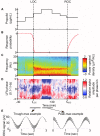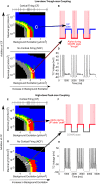Thalamocortical control of propofol phase-amplitude coupling
- PMID: 29227992
- PMCID: PMC5739502
- DOI: 10.1371/journal.pcbi.1005879
Thalamocortical control of propofol phase-amplitude coupling
Abstract
The anesthetic propofol elicits many different spectral properties on the EEG, including alpha oscillations (8-12 Hz), Slow Wave Oscillations (SWO, 0.1-1.5 Hz), and dose-dependent phase-amplitude coupling (PAC) between alpha and SWO. Propofol is known to increase GABAA inhibition and decrease H-current strength, but how it generates these rhythms and their interactions is still unknown. To investigate both generation of the alpha rhythm and its PAC to SWO, we simulate a Hodgkin-Huxley network model of a hyperpolarized thalamus and corticothalamic inputs. We find, for the first time, that the model thalamic network is capable of independently generating the sustained alpha seen in propofol, which may then be relayed to cortex and expressed on the EEG. This dose-dependent sustained alpha critically relies on propofol GABAA potentiation to alter the intrinsic spindling mechanisms of the thalamus. Furthermore, the H-current conductance and background excitation of these thalamic cells must be within specific ranges to exhibit any intrinsic oscillations, including sustained alpha. We also find that, under corticothalamic SWO UP and DOWN states, thalamocortical output can exhibit maximum alpha power at either the peak or trough of this SWO; this implies the thalamus may be the source of propofol-induced PAC. Hyperpolarization level is the main determinant of whether the thalamus exhibits trough-max PAC, which is associated with lower propofol dose, or peak-max PAC, associated with higher dose. These findings suggest: the thalamus generates a novel rhythm under GABAA potentiation such as under propofol, its hyperpolarization may determine whether a patient experiences trough-max or peak-max PAC, and the thalamus is a critical component of propofol-induced cortical spectral phenomena. Changes to the thalamus may be a critical part of how propofol accomplishes its effects, including unconsciousness.
Conflict of interest statement
I have read the journal's policy and the authors of this manuscript have the following competing interests: ENB and PLP are inventors on patents pending on anesthetic brain monitoring that have been licensed by Massachusetts General Hospital to Masimo Corporation. ENB and PLP have received speaker’s honoraria from and ENB has consulted for Masimo Corporation.
Figures









Similar articles
-
Rapid thalamocortical network switching mediated by cortical synchronization underlies propofol-induced EEG signatures: a biophysical model.J Neurophysiol. 2023 Jul 1;130(1):86-103. doi: 10.1152/jn.00068.2022. Epub 2023 Jun 14. J Neurophysiol. 2023. PMID: 37314079 Free PMC article.
-
Propofol-induced loss of consciousness is associated with a decrease in thalamocortical connectivity in humans.Brain. 2019 Aug 1;142(8):2288-2302. doi: 10.1093/brain/awz169. Brain. 2019. PMID: 31236577 Free PMC article.
-
Attenuation of high-frequency (50-200 Hz) thalamocortical EEG rhythms by propofol in rats is more pronounced for the thalamus than for the cortex.PLoS One. 2015 Apr 15;10(4):e0123287. doi: 10.1371/journal.pone.0123287. eCollection 2015. PLoS One. 2015. PMID: 25875024 Free PMC article.
-
Just a phase they're going through: the complex interaction of intrinsic high-threshold bursting and gap junctions in the generation of thalamic alpha and theta rhythms.Int J Psychophysiol. 2007 Apr;64(1):3-17. doi: 10.1016/j.ijpsycho.2006.08.004. Epub 2006 Sep 25. Int J Psychophysiol. 2007. PMID: 17000018 Free PMC article. Review.
-
The role of T-channels in the generation of thalamocortical rhythms.CNS Neurol Disord Drug Targets. 2006 Dec;5(6):571-85. doi: 10.2174/187152706779025526. CNS Neurol Disord Drug Targets. 2006. PMID: 17168743 Review.
Cited by
-
Signatures of Thalamocortical Alpha Oscillations and Synchronization With Increased Anesthetic Depths Under Isoflurane.Front Pharmacol. 2022 Jun 3;13:887981. doi: 10.3389/fphar.2022.887981. eCollection 2022. Front Pharmacol. 2022. PMID: 35721144 Free PMC article.
-
Differences in the EEG Power Spectrum and Cross-Frequency Coupling Patterns between Young and Elderly Patients during Sevoflurane Anesthesia.Brain Sci. 2023 Jul 31;13(8):1149. doi: 10.3390/brainsci13081149. Brain Sci. 2023. PMID: 37626505 Free PMC article.
-
Collapse of Global Neuronal States in Caenorhabditis elegans under Isoflurane Anesthesia.Anesthesiology. 2020 Jul;133(1):133-144. doi: 10.1097/ALN.0000000000003304. Anesthesiology. 2020. PMID: 32282426 Free PMC article.
-
Globus pallidus externus drives increase in network-wide alpha power with propofol-induced loss-of-consciousness in humans.Cereb Cortex. 2024 Jun 4;34(6):bhae243. doi: 10.1093/cercor/bhae243. Cereb Cortex. 2024. PMID: 38850214 Free PMC article.
-
Analyzing Electroencephalography (EEG) Waves Provides a Reliable Tool to Assess the Depth of Sevoflurane Anesthesia in Pediatric Patients.Med Sci Monit. 2019 May 30;25:4035-4040. doi: 10.12659/MSM.915640. Med Sci Monit. 2019. PMID: 31146277 Free PMC article.
References
-
- Miller RD, editor. Miller’s anesthesia. Eighth edition Philadelphia, PA: Elsevier/Saunders; 2015.
-
- Ishizawa Y, Ahmed OJ, Patel SR, Gale JT, Sierra-Mercado D, Brown EN, et al. Dynamics of Propofol-Induced Loss of Consciousness Across Primate Neocortex. J Neurosci. 2016;36: 7718–7726. doi: 10.1523/JNEUROSCI.4577-15.2016 - DOI - PMC - PubMed
-
- Brown EN, Purdon PL, Van Dort CJ. General Anesthesia and Altered States of Arousal: A Systems Neuroscience Analysis. Annu Rev Neurosci. 2011;34: 601–628. doi: 10.1146/annurev-neuro-060909-153200 - DOI - PMC - PubMed
-
- Lewis LD, Weiner VS, Mukamel EA, Donoghue JA, Eskandar EN, Madsen JR, et al. Rapid fragmentation of neuronal networks at the onset of propofol-induced unconsciousness. Proc Natl Acad Sci. 2012;109: E3377–E3386. doi: 10.1073/pnas.1210907109 - DOI - PMC - PubMed
-
- Hanrahan SJ, Greger B, Parker RA, Ogura T, Obara S, Egan TD, et al. The Effects of Propofol on Local Field Potential Spectra, Action Potential Firing Rate, and Their Temporal Relationship in Humans and Felines. Front Hum Neurosci. 2013;7 doi: 10.3389/fnhum.2013.00136 - DOI - PMC - PubMed
Publication types
MeSH terms
Substances
Grants and funding
LinkOut - more resources
Full Text Sources
Other Literature Sources
Molecular Biology Databases

